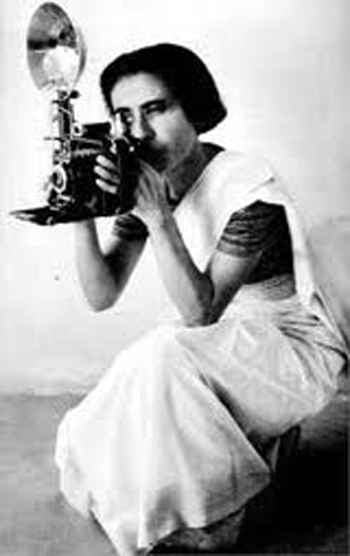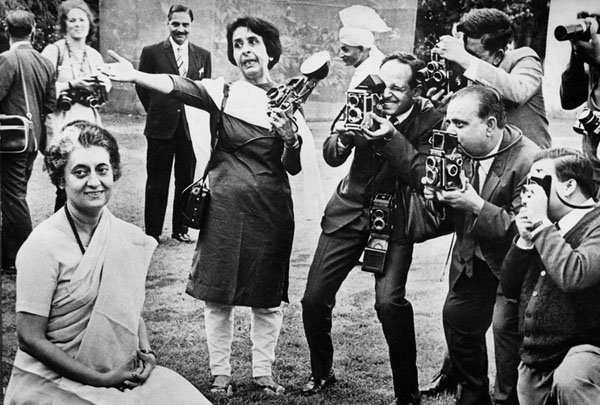Biographer Sabeena Gadihoke?s book on Homai Vyarawalla tells the story of India?s first woman photojournalist who passed away on January 15 2012.
Getting the three of them together for a photograph was a task. The launch function was over and Homai Vyarawalla, Sabeena Gadihoke and Shernaz Cama were dispersed over the Lalit Kaka Akademi grounds in New Delhi.

Guests wanted to meet them, arrangements had to be fine tuned and a self effacing modesty caused them to be inaccessible. Finally they posed for the cover photo with smiles of good cheer.

For over six years the trio had toiled to bring to print the remarkable career of India?s first woman photojournalist of national fame, the 92-year-old Baroda resident who still drives a car, is a do-it-yourself carpenter and starts her day with a broom, sweeping her small apartment.

Vyarawalla?s down-to-earth mannerisms, her ease with talking to people and answering questions endeared her to all present at the function. And her biographer Gadihoke and the person who initiated the subject for the book, Cama, not only complimented Vyarawalla?s presence but added considerable warmth and bonhomie to the event.
Indeed as the chief guest Ambika Soni, minister of tourism and culture for the country observed on February 25, 2006 after inaugurating a photo exhibition of Vyarawalla?s work and the launching of the book?India in Focus: Camera Chronicles of Homai Vyarawalla?the evening was ?a celebration of their association? and she thanked the organizers for calling her to join in the happy occasion. The book is published by the Parzor Foundation in association with Mapin Publishing.
To become ?icons? such as Vyarawalla, ?women have to work harder? than men, observed the vivacious minister and confidante of Congress leader Sonia Gandhi. Gandhi was scheduled to attend the function but was unable to do so.
At a question and answer session on February 26 chaired by noted jurist Tehmtan Andhyarujina, Vyarawalla modestly told the gathering ?that it took me 30 years to realize they (the photographs) had value (and that too) because they told me.? Many of the original prints and negatives were lost or discarded over the years.
Vyarawalla had been part of India?s historical transition from colonial rule to independence, photographed monarchs and nobility, presidents and prime ministers all the while assuming it was a job, a living but one that she enjoyed immensely.
When photographing the high and mighty, Vyarawalla would try to catch them unawares. ?When people know you?re taking their picture, the body language changes. I would wait in a corner till I found somebody interesting ? Nehru knew (people were taking his picture) but acted as though he didn?t ? if he saw me around (he) knew I would photograph him.?
Mahatma Gandhi, she related was exceedingly annoyed with her as she used flash bulbs to which he was averse: ?He ladki?(?girl?)?, he barked, ?tu mujhe andha banaigi our phir jayagi?(?you will make me blind and then go?).?
She recalled the visually and hearing impaired Helen Keller greeting her with a?namaste?? ?That was culture.?
But with the changing times and a more aggressive media, the equation changed. At one function an organizer barked: ?keep those bloody photographers out ? (people) had no idea how to behave in a cultured society ? I didn?t want to be called ?a bloody photographer?. Enough is enough.? She decided to quit the profession in 1970.
Did she want to take it up again? asked a member of the audience. ?If you want to stop, stop it for good ? I started taking interest in gardening.?
What about digital photography? She noted: ?it was very advanced?, but was baffled by all that could be done to alter the image. ?You can?t tell a genuine from a fake. There could be misuse of the technology. I liked the old times when everyone was genuine.?
All her life she had been in the company of men. She believed women were interested only in jewellery, servants? problems, etc. But in Pilani in Rajasthan where she moved to be with her son Farouq she found the stereotype did not hold true. ?I met intelligent women.?
As Gadihoke notes in a letter dated June 26, 2003 to the noted portraiture photographer Dayanita Singh published in the souvenir brought out for the exhibition: ?(Homai) has left ? photography far behind. Now it is Homai the engineer, Homai the architect and Homai?kabariwalla?(old goods dealer) who preoccupy her more. She wants to tell me about the water tank that she has repaired or the money she saved repairing her TV headphone or tips in the kitchen. She loves watching the afternoon soaps (Bhabi?and?Kumkum?are her favorites ? about mother-in-law and daughter in law problems) and a program called?Khana Khazana. Yesterday she repaired my chappal with glue and has asked me to keep some rubber solution with me in my bag always in case I ever need it.?
Gadihoke?s 232-page volume priced at Rs 2,750 tells about the women she greatly admires and features around 450 striking and technically perfect photographs replete with history and spanning a century. ?The genesis of the book lies in?Three Women and a Camera?(1998), a documentary I made of three women photographers including Homai?, states the author. The book tells of Homai?s nomadic upbringing as she travelled with her father?s Urdu drama troupe from Navsari to Singapore, Ceylon, Malaysia, Burma to Bombay.
When a child ?I was not allowed to go to meetings to see all the big people. I didn?t know (that one day) I would meet all these people.?
?I was 13 and going (to Grand High School) with the?mathabanu?made me feel like an old woman ?while going out I would also fold up my?sudreh?into my blouse. I had to remember to let both these items show when I got back home.?
Strapped for finance the doughty girl earned scholarships by offering tuitions to students in the junior classes. She met her husband-to-be Maneckshaw in 1926 at a railway station and as Gadihoke narrates, ?Homai owes her initial interest in photography to Maneckshaw. In days prior to any formal training in the subject, both were self-taught??
?Only a few people attended their wedding ? the entire cost (of which) came to Rs 200 ? we didn?t want mother? to be burdened with expenditure but the real reason was that neither of us liked the elaboratetamasha?(show) that accompanied Indian weddings.? In the evening they went to Chowpatty Beach and atebhelpuri. “?That was our wedding reception?, she notes.
Bombay provided a good ground for aspiring photographers in the 1930s. Their photos appeared in?The Illustrated Weekly of India?and the?Bombay Chronicle?(both now defunct). During World War II the couple were employed by the Far Eastern Bureau of the British Publicity office. They lived in Connaught Place in Delhi.
Sharing a camera with her husband Maneckshaw, nursing her infant son while developing film, having her photographs appear under her husband?s name in case the magazine would not carry a photo shot by a woman, Vyarawalla took it all in her stride.
?I never thought myself to be different? being a woman in a man?s profession, she observed. The only girl in her class at school, Vyarawalla recalled in her working career then there was ?no gender bias ? no embarrassment.? Even the work at home was ?distributed fifty-fifty? between herself arid her husband.
?God helped me all the time ? I was destined to do things.? When asked if she frequented fire temples, Vyarawalla pointed to her heart and said her spirituality resided within.
Partition and independence saw the country in a state of turmoil and Vyarawalla was around to capture the historical event barring perhaps the most momentous one. ?On the 30th?January 1948, Homai was to cover the Mahatma?s prayer meeting at Birla House. Armed with a colour movie camera, she had just stepped out of the office when Maneckshaw called her back. He said that he would accompany her the next day with the still camera. This decision was to cost them dearly. Within a few minutes he returned with all the blood drained from his face. ?I said, what has happened?? He replied, ?Gandhiji has been assassinated!? As the news of the assassination spread, international agencies and newspapers started to call them for images. It was possibly the most important picture that she had missed in her life?, notes Gadihoke.
Maneckshaw passed away in 1969 and his body was cremated at the Nigambodh Ghat. ?Throughout our married life, my husband and I ate from the same plate. It always made reconciliation easier when we had our little differences! After his death, my son and I shared the same plate and when he got married, he shared the same practice with his wife.?
Thirteen years later Farouq died of bowel cancer. ?I know that if things are going to happen in a particular way, you can?t stop them. This knowledge has helped me carryon with life. Try your best and leave it to God. But don?t give up trying. Even now if someone tells me of a death, it doesn?t affect me. I am not heartless, but it doesn?t affect me, because everyone has to go. There is only one certainty in life, and that is death. So why make a fuss about it. Some go early, some go late. I prayed for my husband to go when I saw his eyes turn blue. I would rather have him dead than suffer blindness and disability. I did the same for my son. My mother was al ways afraid of being alone in her death ? but she didn?t have to be. All three of us were there and we were holding her in our arms when she was dying. So some are destined for one thing and others are destined for another.?
Gadihoke tells the story of a vibrant and courageous woman?s life and times with depth and understanding. Her writing is shorn of any pretension or mauldin sentiments. It?s a woman?s story told by a diligent biographer, neither of whom asks for anything in return. Telling the story well is reward enough.
Article by V. Sundaram
Kainaz Amaria on NPR Blog







Leave a Reply
You must be logged in to post a comment.